Thus, what emerges is the picture of a Filipino, either solely or with spouse, catapulted to different parts of the world in search for financial resources to support a family in want back home.
But such is either an incomplete picture, or a picture that does not typify the Filipino in diaspora. Many Filipinos are scattered throughout the nooks and crannies of the globe, for reasons other than want. True, the present phenomenon is of the typical OFW forced to leave for abroad, as the only viable option in his limited perception of the problems that he faces. But recalling past waves of immigration from the old homeland could reveal a more or less truer picture of the different mindsets of the earlier Filipinos who migrated to this country.
Many came to stay for good with their families, made possible by liberal family reunification laws that allowed them to petition up to a certain legal degree their extended families. Of course, this is not to say that those of this mind all have the earnest desire to assimilate into mainstream communities. Rather many have through conscious choices made possible the existence of barrios or cliques, where they can continue to be as Filipino as can be allowed by the rest of the communities that they have invested their lives on.
 One such community is Daly City, a city that shares a contiguous boundary with its northern neighbor, the fabled San Francisco. A city of about 110,000 and where the voters registry shows that a third are FilAmericans. The ratio increases if we include those Filipinos who are still just permanent residents or otherwise and thus not allowed to vote. Now, a unique phenomenon expressed by many has been the cases of Filipinos, many old-timers, who though qualified to become citizens continue holding on to their original nationality. Quite a phenomenon considering that for all intents and purposes they have staked everything in the adopted country – spending countless years here, buying expensive houses, and making investments here.
One such community is Daly City, a city that shares a contiguous boundary with its northern neighbor, the fabled San Francisco. A city of about 110,000 and where the voters registry shows that a third are FilAmericans. The ratio increases if we include those Filipinos who are still just permanent residents or otherwise and thus not allowed to vote. Now, a unique phenomenon expressed by many has been the cases of Filipinos, many old-timers, who though qualified to become citizens continue holding on to their original nationality. Quite a phenomenon considering that for all intents and purposes they have staked everything in the adopted country – spending countless years here, buying expensive houses, and making investments here.Our own family had lived in this area, specifically in the area referred to as “old Daly City”, one close to the boundary with San Francisco. Developed earlier and sharing many similarities with its next-door neighbor. Daly City used to be a haven for a good number of self-exiled Italian Americans as their quiet escape from nearby bustling and congested San Francisco, the monickered Baghdad by the Bay city.
But after a quarter century, we decided to move to our new location and to sell the house which has been in the family for just as many years. Over time we have seen this little enclave metamorphose from an integrated community composed of Italian-Americans, African-Americans, Hispanics, and Filipinos, to a now largely FilAm domain, i.e., the same old houses have been bought and sold by FilAm families. To a point that the most likely expectation I have for our house is that it will sell to another FilAm family.
It may help to understand why Daly City in particular, and not any other city this side of the Bay. And yes, there are also other cities on the other side of the Bay, where Filipinos have also staked out their claims for their own barrios or cliques. Daly City’s proximity to San Francisco plays a very crucial role. The latter is only 10 miles away and can be reached either by private vehicle, by bus, or by rapid transit called BART. And SF is the city where many jobs tailored for the fresh Filipino immigrants can be found and easily secured. Thus, Daly City has been rightfully described as a bedroom community, because workers from SF and elsewhere go there to live, sleep, and raise their families.
Daly City in general, and this part of the city in particular, then should provide a representative slice of the typical life of the Filipino who has decided to consider this place his primary domicile, away from the old homeland which though still continues to exert strong ties, both nostalgic and otherwise.
This morning, I took a twenty-minute leisurely walk around familiar haunts where many of our compatriots gravitate, either to worship, send their kids to school, or buy groceries and other needs, etc. For old Daly City is quite small and quiant and can be easily hiked from any direction in minutes. The pictures provide the illustrations for this little narrative tour.

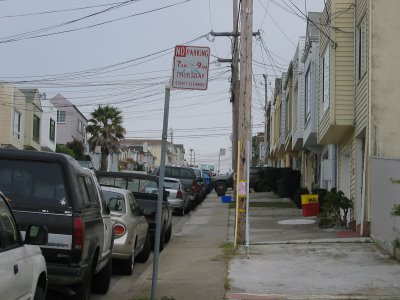

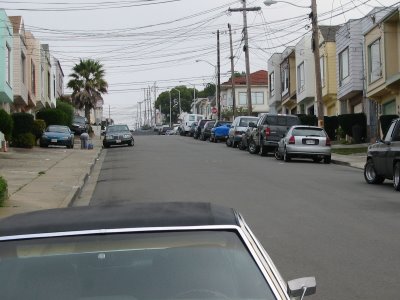 (Click on pictures to enlarge) The pictures above show a typical street scene in the morning during a weekday. Most of the houses, flushed to each other, are owned by FilAms. The streets are empty because most are out at work. Notice also two things about the cars parked curbside, mostly on one side of the street. First, they are outside because the garage spaces have been utilized either as additional storage, or because they have been used (mostly without permit) as added living areas. Second, the cars are parked mostly on one side because of street cleaning, which is scheduled twice in a week, one for each side of the street. The first situation has one native here jestingly remark that only in Daly city can you find “junk” stored inside the garage, but the expensive $20K vehicle is parked outside exposed to the elements.
(Click on pictures to enlarge) The pictures above show a typical street scene in the morning during a weekday. Most of the houses, flushed to each other, are owned by FilAms. The streets are empty because most are out at work. Notice also two things about the cars parked curbside, mostly on one side of the street. First, they are outside because the garage spaces have been utilized either as additional storage, or because they have been used (mostly without permit) as added living areas. Second, the cars are parked mostly on one side because of street cleaning, which is scheduled twice in a week, one for each side of the street. The first situation has one native here jestingly remark that only in Daly city can you find “junk” stored inside the garage, but the expensive $20K vehicle is parked outside exposed to the elements.
 The backyards of the houses around a block are all hemmed in because the houses do not have sideyards or alleys. The back area is completely land-locked and isolated.
The backyards of the houses around a block are all hemmed in because the houses do not have sideyards or alleys. The back area is completely land-locked and isolated.

 K-12 public schools are stragetically located within the residential areas, thus this school in Colma has both elementary and middle (junior HS) grades. It is only two blocks from where we live and is also similarly situated for the rest. Another public elementary school is also two blocks going another way. Kids walk to school and many become latch-key kids after school hours, until their parents arrive from work.
K-12 public schools are stragetically located within the residential areas, thus this school in Colma has both elementary and middle (junior HS) grades. It is only two blocks from where we live and is also similarly situated for the rest. Another public elementary school is also two blocks going another way. Kids walk to school and many become latch-key kids after school hours, until their parents arrive from work.
 Since many Filipinos are Catholic, their places for worship are nearby, many within walking distance. The pictures show the Holy Angels parish, with the parochial elementary grade school tucked behind the imposing church steeple. This parish is one among several in a city now dominated by Filipino parishioners. This particular parish used to be frequented mostly by the Caucasians in the community but they have since gone and moved elsewhere. Now, even the school is run by nuns imported from the Philippines.
Since many Filipinos are Catholic, their places for worship are nearby, many within walking distance. The pictures show the Holy Angels parish, with the parochial elementary grade school tucked behind the imposing church steeple. This parish is one among several in a city now dominated by Filipino parishioners. This particular parish used to be frequented mostly by the Caucasians in the community but they have since gone and moved elsewhere. Now, even the school is run by nuns imported from the Philippines.
 This is Mission Street, the main commercial avenue in the city. It is one of the oldest and longest streets in this part of the state. One can take this road and end up in LA some 400 miles away. These particular shots show Mission Street going north, toward SF which is 10 miles away.
This is Mission Street, the main commercial avenue in the city. It is one of the oldest and longest streets in this part of the state. One can take this road and end up in LA some 400 miles away. These particular shots show Mission Street going north, toward SF which is 10 miles away.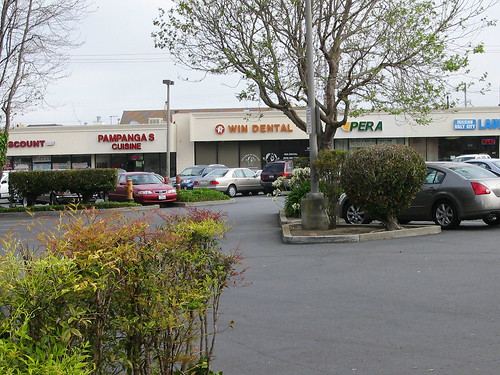
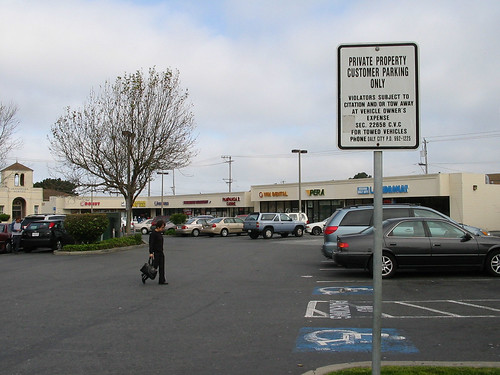
Though nothing compared to the Filipino pride of Daly City, Serra Monte Mall, which has been nicknamed Little Manila, these shots show a strip mall, one among several within walking distance. Notice the signs, Pera and Pampanga’s Cuisine, definitely Filipino enterprises, one engaging in money remittances and the other serving Pampango cuisine. And I did not forget that also nearby along Mission Street and on a more spacious location is Jollibee, banging heads with the likes of Albertson's, a Hawaiian fastfood center, and other specialized and niched eating places.

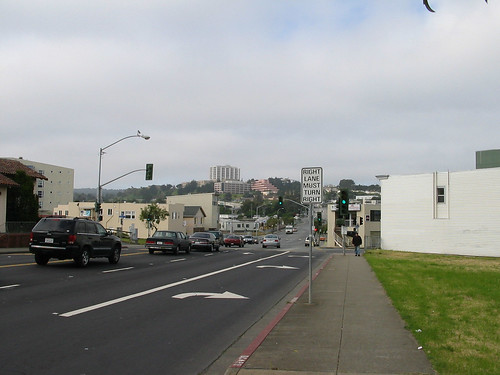
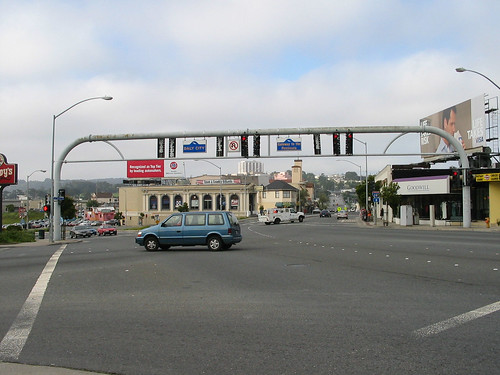
The shots show a well-travelled artery, which connects to the freeway on- and off -ramps. Many of our compatriots use this road to get to the freeway, on their way to work either heading toward SF or going south to such places as South San Francisco, Redwood City, etc. Notice the Philippine Grocery tucked in a rather secluded area with the freeway behind it. The strategic location allows the commuting FilAms to purchase their “baon” from the grocery’s cooked food section on the way to work, and on the trip home, take the off-ramp and pass by the grocery to purchase dinner for the entire family. On the two lower pictures, one can see in the background the unmistakable outlines of another impressive landmark in Daly city, where many FilAm doctors and nurses figure prominently - nestled on a stately hill is the Seton Hospital.
Thus, a cameo of your typical FilAm living away from the old homeland has been attempted. Piecing together their permanent abode and environs, for him and her and their Americanized children, settling and sharing with compatriots their comfortable pockets of relatively convenient but pricey neighborhoods.
A related post:
Profiling The FilAm Homeowner
